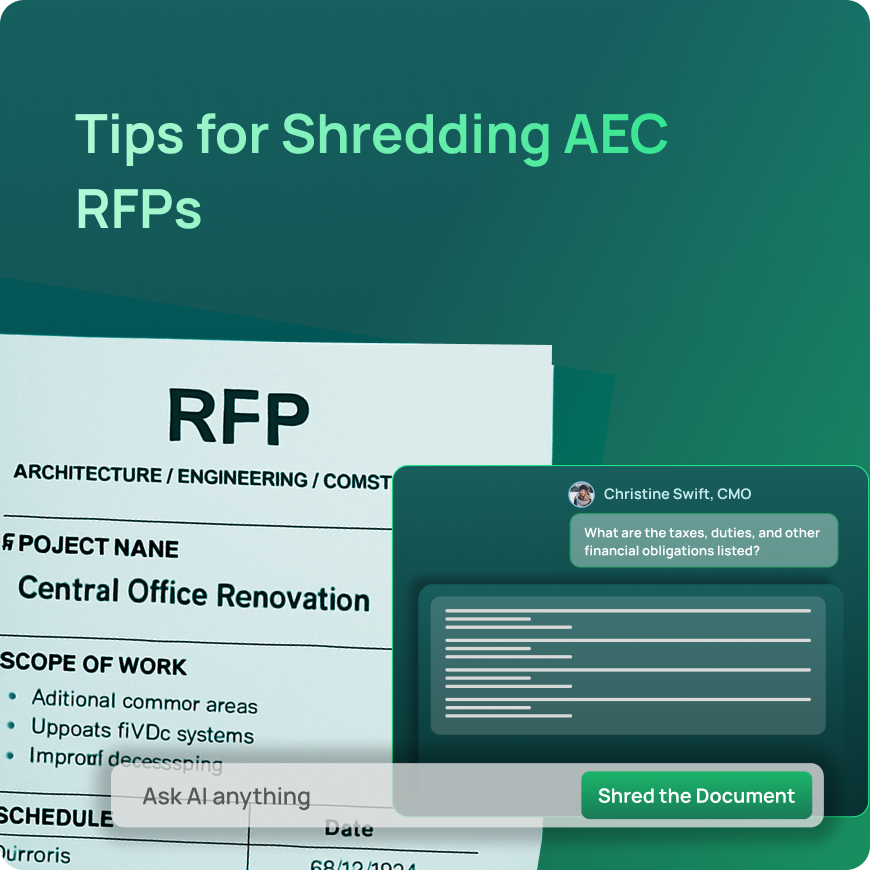Tips for Shredding AEC RFPs Quickly and Accurately
AEC firms often lose millions by chasing the wrong RFPs with slow, manual processes that miss critical risks hidden in 300+ page documents. A smarter shredding process prevents such waste and keeps your team focused on viable, profitable opportunities.

Tips for Shredding AEC RFPs Quickly and Accurately (Executive Guide)
Responding to an RFP (Request for Proposal) in the architecture, engineering, and construction (AEC) industry can feel like a race against time, complexity, and risk. Many firms still rely on manual RFP “shredding” – the process of dissecting RFP documents to extract requirements and key information – which is often described as exhausting, error-prone, and prone to missed opportunities. As a CFO or C-suite leader at a U.S. AEC firm, you understand that proposal operations are not just a back-office function, but a strategic process that impacts your bottom line. The ability to analyze massive RFPs quickly and accurately has become not just a competitive advantage, but a survival requirement in the tightening AEC market. In this guide, we’ll explore how to elevate your RFP shredding process for maximum efficiency, risk mitigation, and competitive positioning.
Data-Driven RFP Shredding: Modern RFP analysis can turn a 300-page RFP document into actionable data, giving executives instant visibility into requirements, risks, and resource needs. By converting voluminous RFPs into structured compliance matrices and summaries, leadership gains a clear view of what it will take to win and deliver the project successfully. This analytic approach not only accelerates proposal preparation but also supports smarter bid/no-bid decisions – ensuring pursuit efforts align with the firm’s financial and operational goals. In fact, AEC firms often lose millions by chasing the wrong RFPs with slow, manual processes that miss critical risks hidden in 300+ page documents. A smarter shredding process prevents such waste and keeps your team focused on viable, profitable opportunities.

1. Assess RFP Complexity Before Choosing Your Approach
Not all RFPs are created equal. Some solicitations are straightforward, with a single well-structured document, while others are sprawling packages with multiple volumes, appendices, and tricky formatting. Before your team jumps into shredding an RFP, have them assess its complexity and structure. Key questions to consider include :
Size & Scope: Is it a brief, simple RFP or a behemoth 300+ page package with multiple documents? Larger, more complex RFPs will strain a manual approach and are good candidates for automation.
Organization: Does the RFP follow a clear, logical structure with defined sections for instructions, scope of work, evaluation criteria, etc., or is it poorly organized? A straightforward outline (e.g., separate Sections for requirements vs. terms) is easier to shred by hand .
Requirement Indicators: Does the RFP use standard keywords like “will,” “shall,” or “must” to identify requirements clearly? Consistent language makes it easier for tools (and people) to spot compliance points.
Formatting Challenges: Are requirements presented in clean, uniform tables or lists, or are they buried in nested tables and merged cells that complicate extraction? Unusual formatting or excessive attachments can confuse both automated tools and human readers.
By answering these questions upfront, your team can determine the most efficient shredding path. If the RFP is small and well-structured, manual shredding may be just as fast as using a tool – and it avoids unnecessary complexity or costs. On the other hand, if you’re looking at a massive, standard-formatted RFP, an automatic shredding tool could save hours of effort and reduce human error. The goal for leadership is to allocate resources wisely: use automation where it pays off, and don’t over-engineer the process for simpler bids. An upfront complexity assessment ensures you’re not using a sledgehammer to crack a nut (or worse, bringing a knife to a gunfight).

2. Leverage Automation Wisely for Speed and Efficiency
For large, complex AEC RFPs that meet the criteria for structure and clarity, automation can dramatically accelerate the shredding process. Modern RFP analysis tools – including AI-driven “shredders” – can scan documents to extract every requirement, clause, date, and compliance item in minutes, creating an organized list or matrix that would take humans days to assemble. In fact, document review cycles that once took days can be cut by 90% or more with the right tools, allowing teams to evaluate and respond to more bids without adding headcount. This kind of efficiency gain directly contributes to operational effectiveness and proposal throughput, something any CFO can appreciate.
That said, automation is not a silver bullet. It must be applied strategically. If an RFP’s structure is too unconventional – for example, if requirements are hidden in convoluted tables or the language is inconsistent – even the best software might stumble. In such cases, forcing automation could lead to incorrect or incomplete results, which then require time-consuming manual fixes. The wise approach is to use automation where it makes sense and provides ROI: typically for larger RFPs with standard formats and repetitive elements. When used appropriately, automation not only speeds up compliance matrix generation but also frees your proposal team to focus on higher-value tasks. Instead of hand-copying requirements all day, your experts can concentrate on solution design, pricing strategy, and crafting persuasive win themes – areas that actually improve your chances of winning and add competitive value.
From an executive perspective, investing in the right proposal tech is about operational efficiency and competitive advantage. The firms that thrive are those that “identify the right opportunities, prepare flawless proposals, and deliver them faster than the competition”. Leveraging automation in RFP shredding helps make this possible. It enables your organization to handle more proposals with the same staff (scaling without extra payroll) and respond faster than rivals, all while maintaining accuracy. In a business where speed and completeness can make or break a deal, smart automation is a strategic asset.

3. Validate and Verify All Outputs for Accuracy
No matter how slick your RFP shredding tool is – or how skilled your team is at manual shredding – you should never skip rigorous validation. Automation can dramatically speed up the work, but it isn’t infallible. Always manually validate the tool’s outputs to catch any glitches or omissions that could introduce errors into your compliance matrix. Think of it as quality control: if the software misses a critical “shall” requirement buried in a table, or accidentally merges two requirements into one, a human reviewer must catch and correct that before your proposal effort moves forward.
Establish a review step where a proposal manager or subject matter expert cross-checks the extracted requirements against the original RFP documents. This is especially important if the RFP had unusual formatting or if certain requirements are vague, overlapping, or contradictory. A second pair of eyes (or a peer review session) can ensure nothing fell through the cracks and that every requirement is correctly interpreted. The extra time spent on verification is minimal compared to the cost of missing a requirement during submission. Remember, in the world of AEC proposals, compliance is non-negotiable – a single missed requirement or formatting error can lead to disqualification.
Validating outputs isn’t just about avoiding mistakes; it’s a key part of risk mitigation in your proposal process. As an executive, insist on a culture where accuracy matters more than speed alone. Given that “one missed form or overlooked clause can cost millions” in lost contracts, investing a bit of time in thorough verification is a no-brainer. This practice significantly lowers compliance risk, protecting your firm from the nightmare of a bid thrown out on a technicality after weeks of work. In short: trust technology, but verify everything.

4. Build a Comprehensive Compliance Matrix (Your Proposal Blueprint)
A compliance matrix is the heart of a well-shredded RFP. It’s essentially a master checklist or table that maps every RFP requirement to your proposal’s response and assigns ownership to team members. Building a comprehensive compliance matrix – and doing it quickly – is critical for both proposal management and executive oversight. It ensures that for every “shall” and “must” in the RFP, your team has a plan to address it (or a conscious decision not to, if you have a strategy around exceptions).
If done manually in a large RFP, creating this matrix can be one of the most tedious and error-prone tasks. Proposal teams may find themselves combing through hundreds of pages, tracking items in spreadsheets, and constantly cross-referencing to make sure nothing is missed. Even with their best efforts, human oversight can lead to costly disqualifications – all it takes is one overlooked requirement to jeopardize the whole bid. This is why using the earlier steps (automation and careful validation) feeds directly into building a solid compliance matrix.
When shredding is done right, you’ll end up with a structured list of requirements that can be exported or organized into a matrix format. Every requirement, from technical specs to legal clauses, should appear in the matrix along with notes on how your proposal will comply. The compliance matrix becomes your proposal blueprint: it guides writers on what to cover, helps project managers assign section leads, and provides executives a one-glance view of coverage and gaps. Many teams also include submission details (due dates, forms to sign, etc.) in the matrix, making it a one-stop reference for proposal compliance.
Importantly, treat the compliance matrix as a living document throughout the proposal development. Update it as clarifications come in or amendments to the RFP are released. Use it in proposal reviews to double-check that every box is truly checked. As one expert notes, an organized compliance matrix is “not just time saved; it’s your safety net against disqualification.” It gives leadership confidence that no requirement is glossed over. By building this matrix quickly and accurately, you create a foundation that keeps the entire proposal team aligned and on schedule, reducing last-minute scrambles. It’s an excellent example of how upfront diligence in shredding pays off in the later stages of proposal production.
5. Manage Proposal Risks Proactively from the Start
Speed and accuracy in RFP shredding are vital, but equally important is what you learn from the process. A thorough shred of an RFP isn’t just about listing requirements – it’s also about surfacing risks and deciding how (or whether) to proceed. Proposal risk management should begin the moment you start analyzing an RFP. As an executive, you’ll want your team to flag any show-stoppers or red flags early: sections that imply unfulfillable requirements, onerous contract terms, or hidden costs that could hurt the project’s profitability.
For example, shredding an RFP might reveal interdependencies or clauses that could turn a “win” into a loss if not addressed. Perhaps there’s a liquidated damages clause with steep penalties for delays, an unrealistic project timeline that would strain your resources, or strict bonding and licensing requirements that your firm can’t fully meet. These findings are pure gold from a CFO’s perspective. They enable a data-driven go/no-go decision before you sink extensive effort into a proposal. Pursuing the wrong RFP is a waste of valuable resources, and too many firms still make bid decisions on fragmented information or gut feeling. Instead, by leveraging a complete RFP shred, your team can quickly assess whether an opportunity is a strategic fit and winnable. In fact, accelerating these bid/no-bid decisions is one of the benefits of efficient RFP analysis – it “reduces the time spent analyzing opportunities that may not align with your company’s strengths.”
If you do proceed with a proposal, the insights from shredding help in mitigating risks in your response strategy. You can allocate contingency costs for risky aspects, adjust your project plan to address tight timelines, or seek clarifications from the client on ambiguous points. The result is that you only promise what you can deliver, at prices that protect your margins. A well-shredded RFP, paired with executive oversight, ensures the projects you win are the ones you can deliver profitably – shielding your firm from clauses or conditions that could otherwise erode margins. This proactive risk management up front can save millions in potential losses or disputes down the line. It also boosts your firm’s reputation for reliability and precision, as you are far less likely to stumble upon nasty surprises after winning the bid.
Finally, don’t overlook the human element of risk: proposal team burnout and overextension. Chasing every opportunity under the sun is not a recipe for success. It leads to staff fatigue and lower quality work, and ironically, a lower win rate. As industry analyses have pointed out, common missteps like “pursuing opportunities that aren’t the right fit, overextending staff, or missing submission requirements” come at a high cost – teams burn out, time is wasted, and viable opportunities slip away. By shredding RFPs thoroughly and focusing on the right bids, you manage your team’s workload and morale as well. In short, strategic RFP shredding helps you bid smarter, not just more – improving both your win rate and your win quality (i.e., winning projects that can be executed successfully).
Executive Takeaway: Efficiency that Drives Competitive Advantage and Profit
In the AEC industry, smart RFP shredding is much more than an administrative task – it’s a strategic lever for performance. By systematically assessing RFP complexity, leveraging automation wisely, insisting on validation, building robust compliance matrices, and managing risks proactively, CFOs and other executives can transform their proposal operations. The payoff comes in multiple forms: faster response times, higher proposal throughput, fewer compliance errors, and better-informed bid decisions. These translate directly into bottom-line impact. Teams that implement these practices have seen document analysis times plummet and are able to pursue more bids without increasing headcount. Fewer bids are lost to technical disqualification, saving the company from the sunk cost of unwinnable efforts. And when a proposal is submitted, it’s more likely to be compliant, compelling, and competitive – which boosts win rates (in some cases by 20–25% through better alignment and completeness).
For U.S. AEC firms facing tightening margins and fierce competition, these improvements are game-changing. An efficient, accurate RFP shredding process means your organization can identify the right opportunities and respond flawlessly faster than competitors. It turns a once tedious process into a source of competitive advantage – a way to outpace rival firms in both speed and quality of proposals. Perhaps most importantly, it ensures that when you win a project, you do so with eyes wide open and a plan to deliver profitably, safeguarding your firm’s financial health.
Executive strategy takeaway: Prioritize and invest in proposal efficiency measures like RFP shredding best practices. They offer not only operational efficiencies but also significant strategic benefits: reduced compliance risk, better resource utilization, improved win outcomes, and protection of profit margins. In a market where one oversight can cost millions, a well-oiled RFP shredding process is an insurance policy and a performance engine rolled into one. By shredding RFPs quickly and accurately, you empower your teams to put their energy where it truly counts – crafting winning proposals and executing projects successfully – driving growth and competitive advantage for your firm. In sum, smarter RFP shredding is smart business. Each improvement in this process directly supports your bottom line, turning proposal management into a catalyst for sustained success.